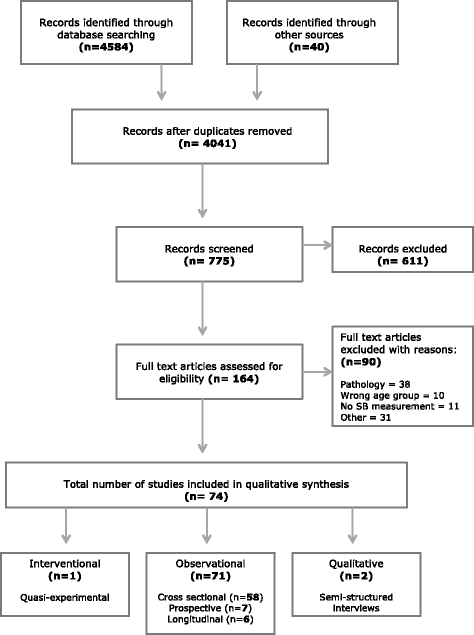A systematic review of correlates of sedentary behaviour in adults aged 18-65 years: a socio-ecological approach
- PMID: 26887323
- PMCID: PMC4756464
- DOI: 10.1186/s12889-016-2841-3
A systematic review of correlates of sedentary behaviour in adults aged 18-65 years: a socio-ecological approach
Abstract
Background: Recent research shows that sedentary behaviour is associated with adverse cardio-metabolic consequences even among those considered sufficiently physically active. In order to successfully develop interventions to address this unhealthy behaviour, factors that influence sedentariness need to be identified and fully understood. The aim of this review is to identify individual, social, environmental, and policy-related determinants or correlates of sedentary behaviours among adults aged 18-65 years.
Methods: PubMed, Embase, CINAHL, PsycINFO and Web of Science were searched for articles published between January 2000 and September 2015. The search strategy was based on four key elements and their synonyms: (a) sedentary behaviour (b) correlates (c) types of sedentary behaviours (d) types of correlates. Articles were included if information relating to sedentary behaviour in adults (18-65 years) was reported. Studies on samples selected by disease were excluded. The full protocol is available from PROSPERO (PROSPERO 2014:CRD42014009823).
Results: 74 original studies were identified out of 4041: 71 observational, two qualitative and one experimental study. Sedentary behaviour was primarily measured as self-reported screen leisure time and total sitting time. In 15 studies, objectively measured total sedentary time was reported: accelerometry (n = 14) and heart rate (n = 1). Individual level factors such as age, physical activity levels, body mass index, socio-economic status and mood were all significantly correlated with sedentariness. A trend towards increased amounts of leisure screen time was identified in those married or cohabiting while having children resulted in less total sitting time. Several environmental correlates were identified including proximity of green space, neighbourhood walkability and safety and weather.
Conclusions: Results provide further evidence relating to several already recognised individual level factors and preliminary evidence relating to social and environmental factors that should be further investigated. Most studies relied upon cross-sectional design limiting causal inference and the heterogeneity of the sedentary measures prevented direct comparison of findings. Future research necessitates longitudinal study designs, exploration of policy-related factors, further exploration of environmental factors, analysis of inter-relationships between identified factors and better classification of sedentary behaviour domains.
Figures
References
-
- Wilmot EG, Edwardson CL, Achana FA, Davies MJ, Gorely T, Gray LJ, Khunti K, Yates T, Biddle SJH. Sedentary time in adults and the association with diabetes, cardiovascular disease and death: Systematic review and meta-analysis. Diabetologia. 2012;55(11):2895–905. doi: 10.1007/s00125-012-2677-z. - DOI - PubMed
Publication types
MeSH terms
LinkOut - more resources
Full Text Sources
Other Literature Sources
Medical


